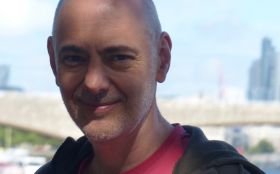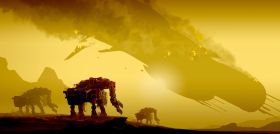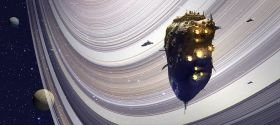An Interview with artist/writer Fred Gambino
Interview questions from Patrick Mahon to Fred Gambino, ahead of the launch of his debut novel ‘Dark Shepherd’, which is being published by NewCon Press on 14 May 2024
Patrick Mahon. Many of SFCrowsnest’s readers will know you as a visual artist. What led you to become a novelist as well?

Fred Gambino: The subjects I was good at at school were art, English and woodwork. I briefly entertained the idea of being a joiner’s apprentice, making a living was something of an imperative I was constantly reminded of, but I also thought I might be a writer. I read a book a week when I was a teenager and have been writing stories almost as long as I have been drawing pictures, but pressure to make a living eventually persuaded me that I should go to art college.
Years later, when working as a concept artist in Dallas, I found that I was the only person in our group that didn’t have what we would now call an IP or Intellectual Property. Out on the bike one day, the kernel of the ‘Dark Shepherd’ story occurred to me and I wrote it up so that I too would have a story. Over the years I have written it on and off and invariably had a positive response whenever I showed it to anyone. That’s what kept my interest in it alive.
PM: Who or what would you cite as major influences on your writing?
FG: Without doubt the golden age writers who I read avidly as a teenager. Authors like Arthur C Clarke, Larry Niven and Isaac Asimov. Latterly, Iain M Banks has been a huge influence.
PM: ‘Dark Shepherd’ is your debut novel and the first in a projected series. Can you tell our readers a little about the story?
FG: Yeah. Breel works on the Beach, in charge of a team of huge dismantler machines that break up end-of-the-line spaceships that are crashed from orbit in order to begin the break-up process. She falls foul of the Church of Second Light, a hugely powerful religious sect that converts whole planets to its tenets. She ends up on the run, pursued for a secret she doesn’t even know she possesses, with a band of insurgents who travel to a distant wormhole or RIP in the universe, within which lurks something ancient, powerful and malevolent.
PM: Did the storyline of ‘Dark Shepherd’ come to you fully formed or did it evolve in the writing?
FG: The basic kernel of the story occurred to me, but it has changed enormously since its inception. Originally, Breel was a sort of Lara Croft in space character but she ended up as an underdog, an innocent abroad in a dangerous universe.
PM: The main baddies in the story are from a powerful religious cult. Was there a particular reason for that choice?
FG: I think, especially in these very polarised times, that beliefs, whether they be religious, political or just downright flat-earth crackpot, are fundamental. We are strange animals that all live in a simulation. I don’t mean some god-like Matrix, but a simulation created by our own brains, forever encased in darkness that creates our perceived reality of light and colour. Once the brain has done its processing, it’s served to us, whatever we are, our consciousness, several nanoseconds after it has all happened. There’s a great line in ‘All The Light We Cannot See,’ by Anthony Doerr: ‘a kilogram of matter, forever in darkness, in which universes spin.’ We all live in a story in the past after a fashion, so it’s no wonder that stories are so important to us as a species. We use them to make our society work. If enough people can be persuaded to believe or fear a story, it can fundamentally reshape the way we live.
My mother was an ‘ordinary’ catholic, if I can put it that way, but something changed as she got older. My father, who always professed to believe in God but not in Priests, put it down to a visit she had from the local Catholic priest, a visit he was excluded from. She changed after that, became much more fundamental and became obsessed with the afterlife, she was going to have, losing interest in the one she was actually living. It made me think a lot about why we believe the things we do.

PM: Without giving away any spoilers, what can we expect from book 2 in the ‘Dark Shepherd’ series?
FG: Book two carries on where book one left off. Our heroes get to explore what lies on the other side of the RIP. It will tie up a lot of loose ends and introduce some new characters.
PM: For those SFCrowsnest readers who aren’t already aware of your career as a visual artist, can you tell us a bit about your work as an artist and illustrator over the last few decades?
FG: I started as a book cover illustrator, working traditionally at a time when the idea of working digitally, the way we do now, would have been considered Science Fiction. It was mainly Science Fiction books I was interested in, but I did covers for all sorts of genres, including war and historical romance. Safe to say that the historical romance covers probably aren’t my best work.
When digital came along, I was an early adopter, which enabled me to make the transition to a concept artist for film and games, just as the bottom was falling out of the book cover market. Looking back, it’s been a blast, enabling me to work in places like Dallas, LA and Vancouver and work on some top movies in London, like ‘Guardians Of The Galaxy’ and ‘Thor: Ragnarok’.

PM: How does your long experience as a visual artist, including your work on several Hollywood films, inform your more recent work as a novelist?
FG: It’s all storytelling, whether you are drawing or writing, but working in the film industry, where everyone is so focused on story was something of a crucible. I’m very much visually orientated, so I tend to think in pictures. When I read, I see a string of images as if I’m watching a movie. The first ideas for ‘Dark Shepherd’ came to me that way, but there was a lot of cross-fertilisation. I would write, then illustrate and then, quite often, change the text based on what I drew.
For example, there’s a design for the salvage tug ‘Recon 3’ which you can see on my website, in the Dark Shepherd gallery (www.fredgambino.co.uk/dark-shepherd-gallery).
I originally described it as a machine with an open cage-like cockpit and an emergency compartment at the back. I designed it that way, but I added a big manipulator claw underneath. It’s a salvage tug after all, so then I went back to the text and included the claw as a means to anchor the ship. Something similar happened with the design of the Dismantler, which can also be seen on the same page of my website.
PM: What does your typical day look like when you’re writing? Do you have one?
FG: Not really, as I’ve never been a proper writer as such, until now maybe. I used to fit it in when I could or when the muse took me. What I find, though, is that although it’s sometimes hard to start, once I do it’s hard to stop. Whole days just disappear, but I’m that way when painting as well.

PM: What are you working on now, if you don’t mind telling us about it?
FG: I’m mainly concentrating on writing book two, which has been commissioned by NewCon Press and is scheduled to be published in 2025. I’m also getting together an exhibition of oil paintings for the Science Fiction Worldcon in Glasgow in August. For the first time in decades, I will have an exhibition of art that will be mainly traditional, not digital. Some of the paintings will have ‘Dark Shepherd’ themes.
If your readers would like to see the images, they can be seen at the aforementioned Dark Shepherd gallery on my website (www.fredgambino.co.uk/dark-shepherd-gallery ), along with some animations of the spacecraft. They might enjoy seeing the book come to life that way.
PM: What have you found are the pros and cons of being a novelist, compared to being a visual artist?
FG: You are very much on your own as a writer and it’s hard to get feedback. You can get an instant reaction to an image, but a novel requires someone to give up hours of their life in order to make your endeavour better. I salute beta readers everywhere, especially my friends and my partner, Jenny, who selflessly gave up their time. Without them, the first book wouldn’t have happened.
PM: Is there anything about your career that you would do differently, if you had the chance?
FG: I would have looked for a better college course to attend. I did a vocational graphic design course, again because I was told it would be much easier to make a living as a graphic designer than an illustrator or artist. I almost left at the end of the first year, to do a Foundation year, which would have let me choose something more art-related, but I chickened out. I think if I had done that I would have got to a better place as an artist more quickly. I ended up being pretty much self-taught. My best art education came from working in the film studios alongside people much more talented than me. I learned a lot from the experience.

PM: What advice would you give to aspiring genre writers or artists?
FG: Do what you love and spend a lot of time doing it. When things go wrong, as they invariably will, pick yourself up, get your head down and keep going. Grab any opportunities that come your way with both hands and run as far as you can with them. That’s the only way really and it will apply whatever the changing landscape of art looks like at the time you’re crossing it.
PM: Thank you.
© Interview: Patrick Mahon, Fred Gambino and SFCrowsnest 2024
